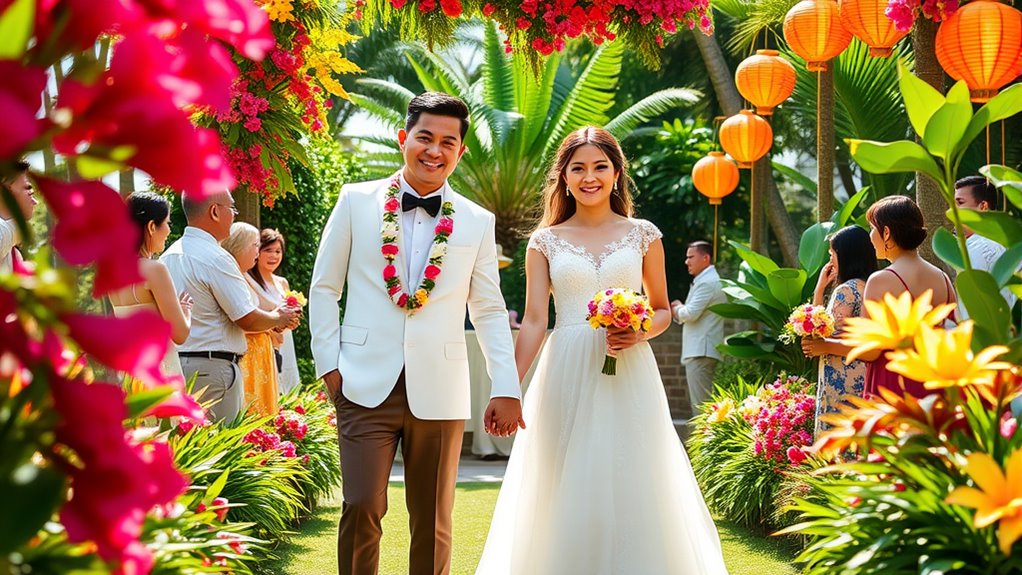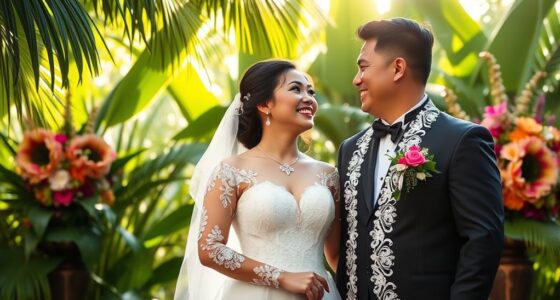Your Filipino wedding beautifully unites two worlds by merging rich pre-colonial traditions with modern influences. You’ll find vibrant rituals like the blood unity ceremony alongside Spanish-influenced customs such as the cord and veil. Traditional attire like the Barong Tagalog honors heritage, while contemporary elements add a personal touch. This celebration emphasizes family involvement and community support, creating a deeply meaningful experience. Discover how these symbolic rituals weave together to form a unique love story that’s all your own.
Key Takeaways
- The wedding blended pre-colonial rituals, like the blood and unity water ceremony, with Spanish Catholic customs, creating a unique cultural fusion.
- Traditional attire showcased heritage, with the groom in a Barong Tagalog and the bride in a Filipiniana, symbolizing respect and cultural pride.
- Family involvement was crucial, with the Pamanhikan formally seeking parental blessings and extended relatives participating in planning and expenses.
- Symbolic elements like the veil, cord, and arrhae highlighted unity and shared responsibilities, reflecting traditional beliefs and modern interpretations.
- The vibrant celebration featured a procession with bolos and musicians, honoring both indigenous heritage and contemporary Filipino culture.
Pre-colonial Wedding Traditions
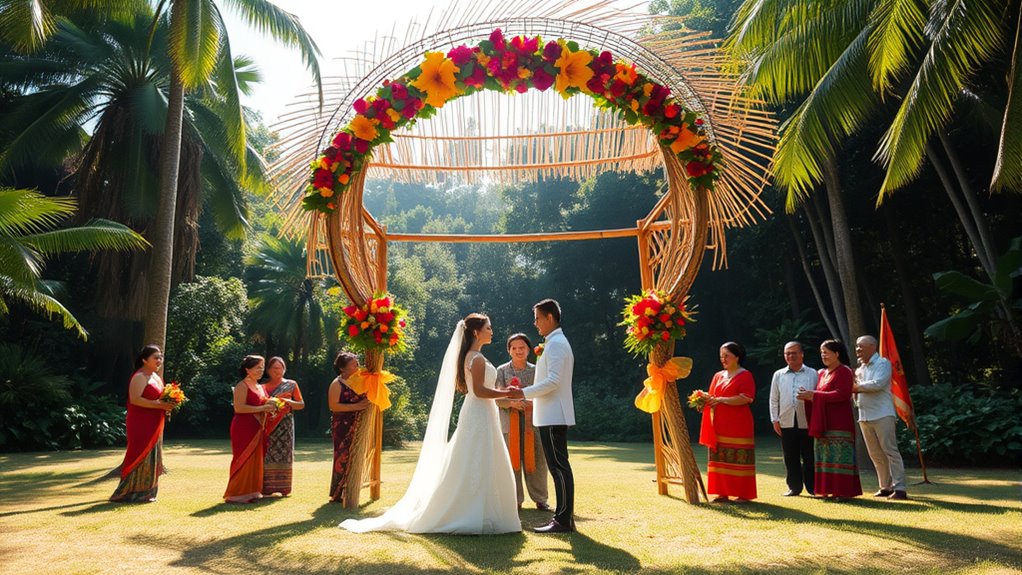
Pre-colonial wedding traditions in the Philippines were rich with rituals and customs that reflected the culture’s deep spiritual beliefs and communal values.
Before the ceremony, you’d avoid travel to prevent accidents, and the bride wouldn’t wear pearls, as they symbolize tears.
The procession would be vibrant, with men wielding bolos and musicians playing agongs. A babaylan, acting as the shaman, would conduct the ceremony at a sacred site, often their home.
During the vows, you’d declare your love three times, and a blood ritual would blend your blood with unity water, symbolizing lifelong commitment.
After the ceremony, sharing cooked rice from one bowl would signify unity, while family and community played essential roles in celebrating this sacred union.
The Influence of Spanish Colonialism

The arrival of Spanish colonialism greatly transformed wedding customs in the Philippines, intertwining indigenous traditions with Catholic practices.
Catholicism became the dominant religion, introducing rituals like the veil, candle, cord, and arrhae, which are now integral to Filipino weddings. You’ll notice similarities with Mexican weddings, reflecting cultural exchanges during the Spanish era.
The Roman Catholic Church plays a central role, requiring couples to follow canonical practices and often conducting ceremonies. Parental consent for marriage, emphasized under Spanish laws, remains essential today.
You’ll find that the cord ceremony symbolizes unity, while banns announce upcoming marriages. Overall, these Spanish influences continue to shape the rich tapestry of modern Filipino weddings, blending tradition with contemporary elements.
Traditional Attire: A Cultural Reflection
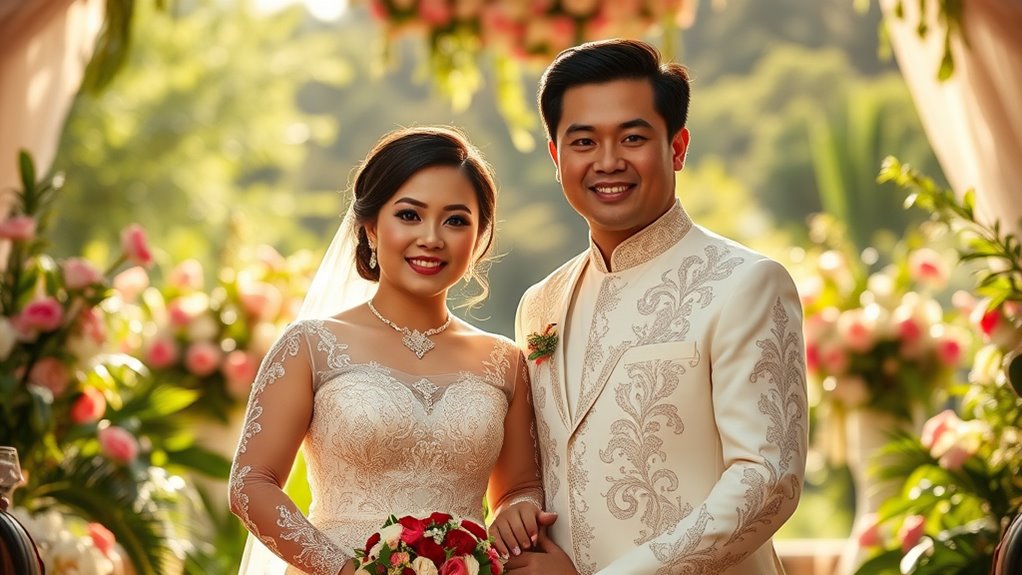
When you attend a Filipino wedding, the traditional attire offers a vivid glimpse into the country’s rich cultural heritage. You’ll likely see the Barong Tagalog, a beautifully embroidered long-sleeved shirt worn by men, symbolizing respect for family and tradition.
Women often don the Filipiniana, characterized by butterfly sleeves and made from pineapple fabric, showcasing cultural significance.
While modern trends introduce Western-style dresses and tuxedos, many couples blend these elements, creating unique attire that reflects personal style and identity.
The colors also carry meaning; white symbolizes purity, while others may signify joy.
Ceremonial Traditions That Bind
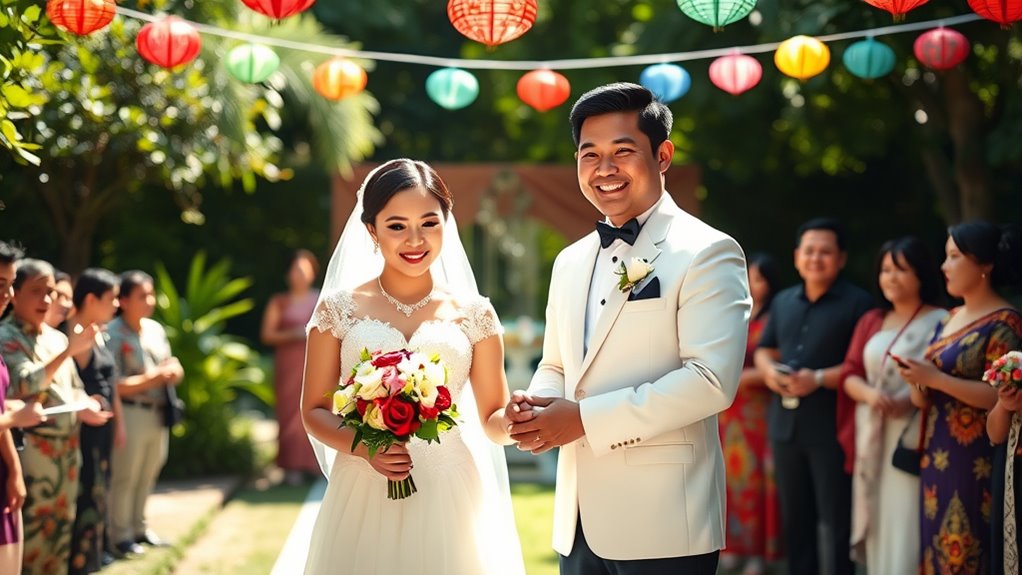
As you witness a Filipino wedding, the ceremonial traditions that bind the couple together are just as vibrant as their attire.
The exchange of arrhae, or coins, symbolizes their shared financial responsibilities. Lighting candles, often done by *ninongs* and *ninangs*, represents unity. The veil placed over the couple signifies oneness and protection, while the cord symbolizes eternal unity, binding them together.
Additionally, the couple may partake in a rice blessing, honoring historical practices. Each ritual reflects a blend of indigenous and Spanish influences, creating a rich tapestry of meaning.
These ceremonies not only unite the couple but also honor the community and cultural heritage, making the celebration truly unforgettable.
Family and Community Involvement
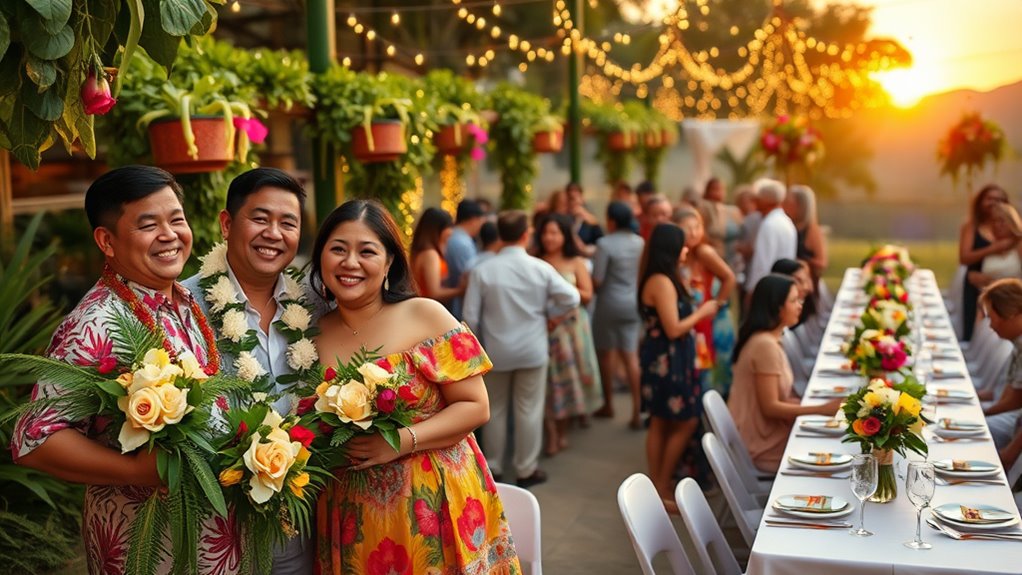
In Filipino weddings, family and community involvement plays a pivotal role, ensuring that the celebration reflects the collective spirit of unity and respect.
During the pamanhikan, you formally request the bride’s parents for her hand in marriage, highlighting the importance of familial ties. Your family typically covers wedding expenses, while extended relatives join in the planning process, strengthening bonds.
The pamanhikan emphasizes familial bonds, with families collaborating on wedding expenses and planning to strengthen connections.
Community participation also shines through, with Principal Sponsors, or Ninang and Ninong, serving as guiding figures. Their support echoes the cultural values of respect and unity.
Seeking parental blessings during the ceremony, often expressed through a hug or kiss, symbolizes acceptance and honor.
This deep-rooted involvement creates a rich tapestry of relationships and traditions that enhance your wedding experience. The emphasis on family welfare during such events mirrors the significance of maintaining strong familial ties, especially in challenging times.
The Significance of Symbolic Rituals

Symbolic rituals in Filipino weddings embody deep cultural significance, weaving together faith, family, and tradition.
For instance, the unity candle lighting represents the merging of two families and Christ’s presence in the couple’s life. Candles, believed to signify God’s presence, reflect the spiritual foundation of the union.
The arrhae, or thirteen coins, symbolize the groom’s commitment to support his wife and future children. Additionally, the cord and veil represent eternal bonds and unity.
Involving secondary sponsors highlights the community’s role, while naming *ninongs* and *ninangs* symbolizes guidance for the newlyweds.
These rituals not only celebrate love but also reinforce cultural values, making the wedding a profound expression of shared beliefs and heritage. Moreover, the significance of emotional intelligence in relationships can enhance the couple’s understanding of their roles within the family and community.
Modern Adaptations of Filipino Weddings
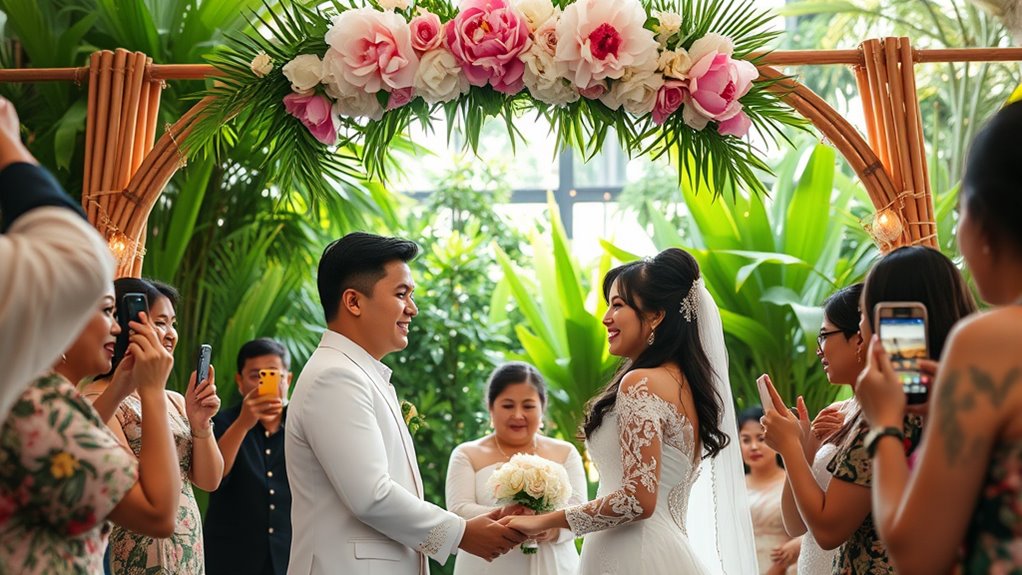
While many couples honor traditional elements in their weddings, modern Filipino weddings also embrace innovative adaptations that reflect contemporary tastes and lifestyles.
You might choose a Barong for both genders, allowing bridesmaids to sport this unique attire. Filipiniana dresses evolve with smaller butterfly sleeves and lighter fabrics, merging tradition and modernity.
When it comes to venues, consider non-traditional spaces like beaches or gardens, or even intimate home ceremonies. You can add tropical themes and global inspirations to your setting.
For food, incorporate local flavors like ube, or opt for fusion cuisine to delight your guests.
Emphasizing family, you can adapt traditional dances and include modern twists in your celebrations, ensuring a memorable experience for everyone involved.
Frequently Asked Questions
What Are Common Wedding Venues for Modern Filipino Weddings?
Common wedding venues for modern Filipino weddings include luxurious estates like Palacio de Memoria and high-end island venues such as Balesin Island Club.
You might also consider contemporary hotel venues like Shangri-La The Fort, which offer modern amenities.
If you prefer something unique, think about outdoor settings like Masungi Georeserve in Rizal or even a yacht wedding on The Party Yacht in Manila.
Each option provides a distinctive atmosphere for your special day.
How Long Does a Typical Filipino Wedding Ceremony Last?
A typical Filipino wedding ceremony lasts about an hour, especially if it includes a Mass or religious service.
If you opt for a non-church ceremony, it might take around 20 to 30 minutes.
Traditional ceremonies, however, could stretch over three days, blending various customs.
Modern weddings often combine these cultural elements, so the duration can vary based on your chosen traditions.
Are There Specific Wedding Dates Considered Lucky in Filipino Culture?
In Filipino culture, wedding dates symbolize new beginnings, much like a blooming flower under a waxing moon.
You’ll find that certain days are considered lucky for tying the knot. Saturdays are often preferred, as they bring a sense of joy and celebration.
Avoid Tuesdays and Fridays, as they carry the weight of superstition.
What Are Popular Wedding Reception Themes in the Philippines?
When planning a wedding in the Philippines, you’ll find several popular reception themes to choose from.
A beach wedding offers a stunning seaside backdrop, while a rustic wedding brings natural charm with wood and burlap.
You might opt for a Filipiniana theme to celebrate culture, or a garden wedding surrounded by lush greenery.
If you prefer modern aesthetics, contemporary minimalist or whimsical themes can create a unique atmosphere that reflects your style.
How Do Filipino Weddings Incorporate Modern Technology?
Filipino weddings incorporate modern technology in several exciting ways. You can live-stream your ceremony, ensuring loved ones who can’t attend in person still feel included.
Digital invitations reduce paper waste, while online platforms simplify planning. Social media lets you share special moments instantly.
Plus, modern elements like video messages from absent guests and themed decor allow you to blend tradition with contemporary flair, creating a unique and memorable celebration.
Conclusion
As you reflect on the rich tapestry of Filipino wedding traditions, it’s fascinating to note that over 80% of Filipino couples still incorporate cultural elements into their ceremonies today. This blend of history and modernity not only honors family heritage but also unites diverse backgrounds, creating a truly unique celebration. Whether it’s the vibrant attire or meaningful rituals, each aspect reflects the deep connections that bind you and your loved ones, making your wedding a memorable fusion of worlds.
